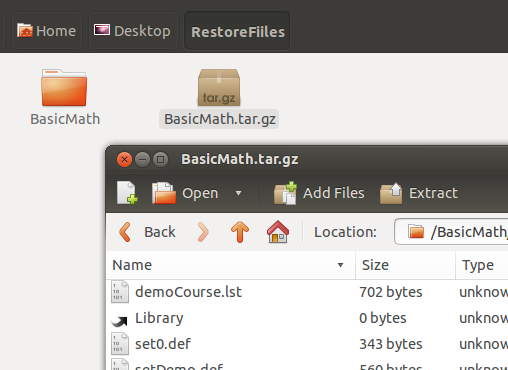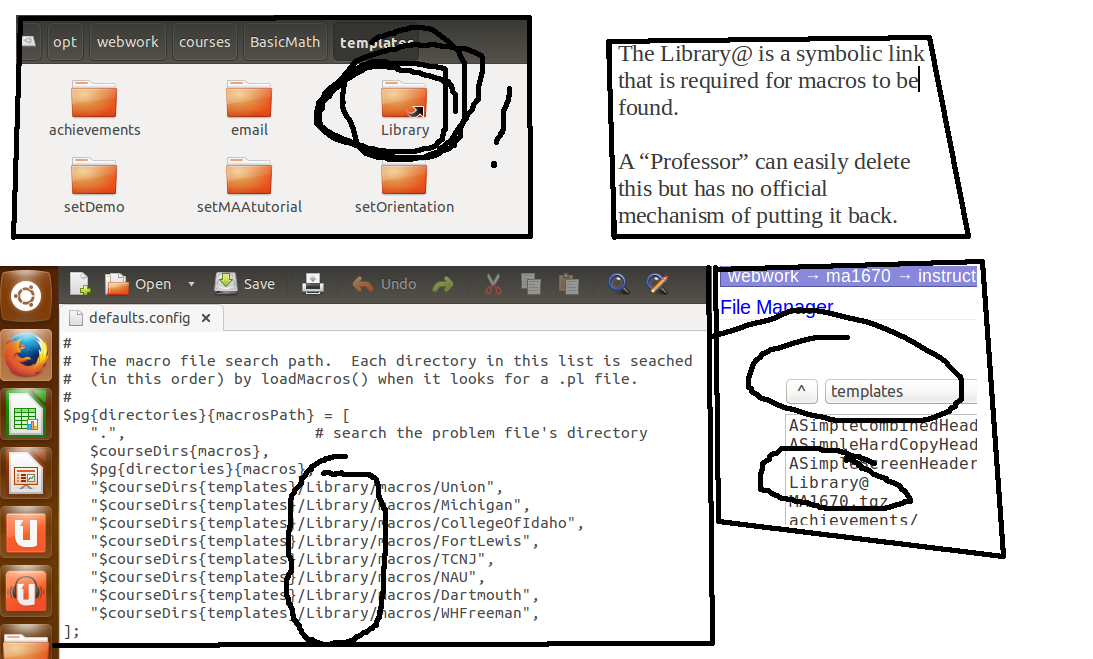Is this link any benefit to the "Professor"?
The "Professor" can easily delete this link and have no official mechanism to put it back; the paths to the marcos would then be broken.
Is there a better way of doing this?
HP asked 'Is this link any benefit to the "Professor"?'
In the context of your upper-left screenshot, I suggest double-clicking on the Library icon and exploring will help you answer your question. Hint: more than macros are involved. (Note: in that desktop context, the command "Move to Trash" is disabled when Library is the selected object.)
---------------
On the other hand, as an experiment, I created an item functionally identical to Library (created in a standard fashion involving escalation of privileges) in a sandbox course, Using File Manager, I selected the new item and clicked on the Delete button. I got the warning
Warning: You have requested that the following items be deleted
LibFake@
Some of these files are directories. Only delete directories if you really know what you are doing. You can seriously damage your course if you delete the wrong thing.
and was then able to delete the item (even though other access had shown it to be owned root:wwdata rather than www-data:wwdata).
---------------
HP also asked "Is there a better way of doing this?"
What does "this" refer to?
In the context of your upper-left screenshot, I suggest double-clicking on the Library icon and exploring will help you answer your question. Hint: more than macros are involved. (Note: in that desktop context, the command "Move to Trash" is disabled when Library is the selected object.)
---------------
On the other hand, as an experiment, I created an item functionally identical to Library (created in a standard fashion involving escalation of privileges) in a sandbox course, Using File Manager, I selected the new item and clicked on the Delete button. I got the warning
Warning: You have requested that the following items be deleted
LibFake@
Some of these files are directories. Only delete directories if you really know what you are doing. You can seriously damage your course if you delete the wrong thing.
and was then able to delete the item (even though other access had shown it to be owned root:wwdata rather than www-data:wwdata).
---------------
HP also asked "Is there a better way of doing this?"
What does "this" refer to?
"this" would refer to completing the link to find the macros.
If more than this is involved - I stand down.
Otherwise:
"$courseDirs{templates}/Library/macros/Union",
of which there would many Library@ links, one for each course installed.
- could (?) be replaced by
"courses/Library/macros/Union",
where there is only one Library@ for the installation [in the "parent" directory "courses"]
One is intuitively simpler than many.
---------------------------------------------------
I do sit back and wonder how it all could be working.
The Library@ scares me in another way. When you "Archive this Course" the Library@ link is included in the archive (see attachment). The archive could very easily have come from a machine where Library@ points to a subdirectory in the NPL library and is being installed on a machine using the OPL library. How is this handled??
I don't understand how all of this works; I am only trying to point out concerns before they become torments. Only recently a problem was posted to the forum that I had noticed much prior and had just "assumed it was me and mine".
Cheers - hp
If more than this is involved - I stand down.
Otherwise:
"$courseDirs{templates}/Library/macros/Union",
of which there would many Library@ links, one for each course installed.
- could (?) be replaced by
"courses/Library/macros/Union",
where there is only one Library@ for the installation [in the "parent" directory "courses"]
One is intuitively simpler than many.
---------------------------------------------------
I do sit back and wonder how it all could be working.
The Library@ scares me in another way. When you "Archive this Course" the Library@ link is included in the archive (see attachment). The archive could very easily have come from a machine where Library@ points to a subdirectory in the NPL library and is being installed on a machine using the OPL library. How is this handled??
I don't understand how all of this works; I am only trying to point out concerns before they become torments. Only recently a problem was posted to the forum that I had noticed much prior and had just "assumed it was me and mine".
Cheers - hp

